AIR BRICKS & AIR VENTS
Including a creaking ground floor
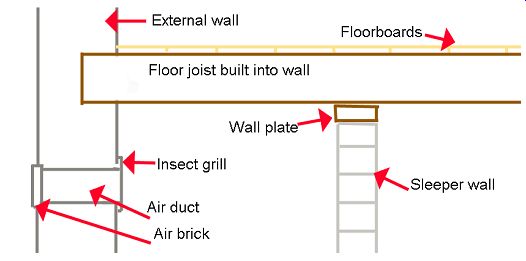
Most properties with wooden floors on the ground floor will have a void underneath. Air in this void can get stale and humid. Humid air carries a great deal of moisture which, at night when the heating is off indoors, can condense on the cooler surface of the floor joists or boards.
This condensation (See our project) can cause the boards and joists to rot from the underside.
As with all condensation related problems the only treatment is ventilation and all properties with hollow floors have air bricks built into the wall to allow a free flowing passage of air. The down side of these air bricks is that the air under the floor can produce a bit of a draught up through the gaps in the floor boards. Many properties, because the owners new no better, have had the air bricks blocked up or even removed. Some have had some blocked up on one side of the house and the other side has been left open and lastly, because these days a conservatory is a relatively cheap and easy way of getting an extension, the floor slab of the conservatory has blocked up the air bricks.
It is important that these air bricks are opened up again. They must be all round the house to allow the air to flow back and forth. Recommended spacing is 1800 mm.
If your floor is draughty see our project on filling gaps in floorboards, but do not block the air bricks. At best you will get some damp and mould and the worst case scenario leads to dry rot.
Air bricks can be inserted easily enough. The first stage is to remove a section of wall large enough to insert one. No lintel is necessary over an air brick. Use our replacing a damaged brick project as a guide to getting a hole made. Choose your air brick. In most situations for hollow floors a 9 inch x 3 inch air brick will be adequate providing there are enough of them at suitable spacings. Air bricks can be bought in clay or plastic. Click on the images to buy the plastic (less easily broken) variety.
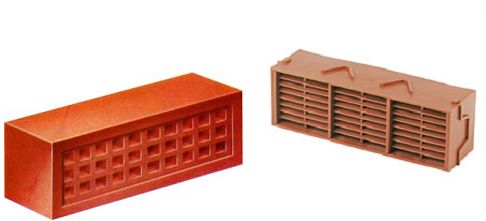
Having cut a hole through the wall. (If you have a cavity wall you may need to hire some extra long masonry drill bits from your local tool hire shop. These can be bought in varying diameters and up to 600mm long. We suggest you hire a 300mm long, 10mm bit for this project.) you need to provide a duct to stop debris blocking the hole in the future. This is done by the use of a special venting duct called a sleeve. Click on the sleeve to buy.
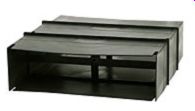
Simply push the sleeve through the wall and then lay your air brick in the hole and re-point. In some situations, for example where the external ground level has been raised over the years, the required height for an air brick is below this level. A special sleeve can be used in these cases. This involves digging a hole to the correct level which should be at least 2 inches below the underside of the floor and ideally an inch or so below the level of the underside of the floor joists, and cutting through the wall at that level. The hole this time must be much larger as you need to get the staggered sleeve into the inside of the wall and build in the stagger so the top section is flush with the external face. Click on the vent below to buy.
The upright section is designed to fit into a cavity if your wall has one.
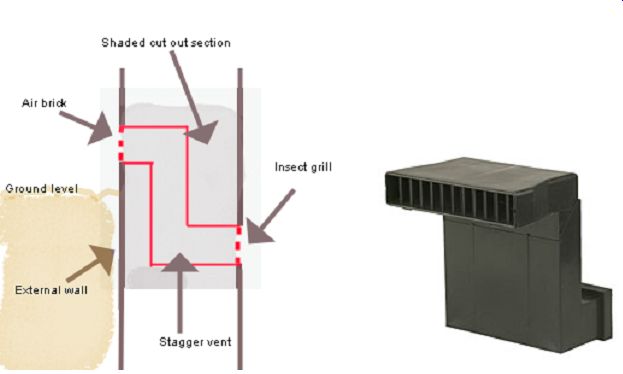
Similarly, if you are to construct anything against your house, e.g. a conservatory or extension, and this construction will block up any air vents, provision must be made to extend these vents beyond the new construction. This can be done very simply with 4 inch drain pipes laid side by side as extension tubes for your vents. The drain pipe must slope a very tiny bit to the outside of the property to prevent water ingress.
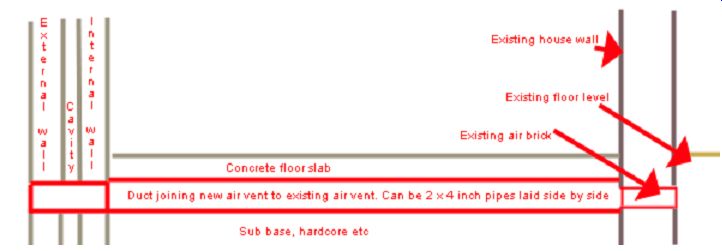
Creaking timber ground floor:
The joists supporting your timber floor have to be supported themselves and this is normally done with sleeper walls constructed before the floor was laid. To allow the air to flow around and through these wall, the brickwork is very often laid in honeycomb bond.
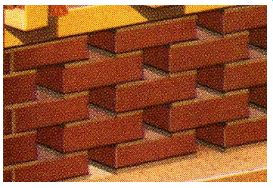
As you can see from the first image at the top of the page, a timber wall plate is laid on top of the sleeper wall to allow a fixing from the joist to the wall to be applied. Unfortunately with the passing of time and the possible closure of some air bricks, it is very often this wall plate which deteriorates first. Either that or the mortar underneath is becomes crumbly and the plate, with the weight of the joists on it, sinks. This allows the joists to "spring" and the floor becomes like the bed of a trampoline. If this is happening in your house then there is no alternative but to replace the wall plate. See our replacing a timber floor project for help with this.
---------